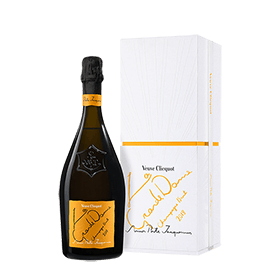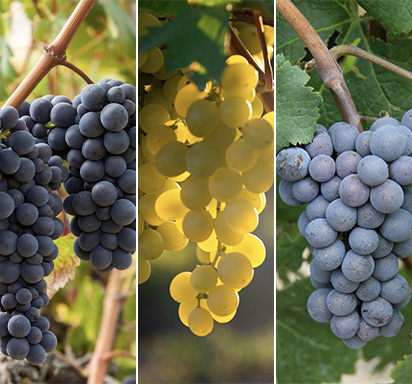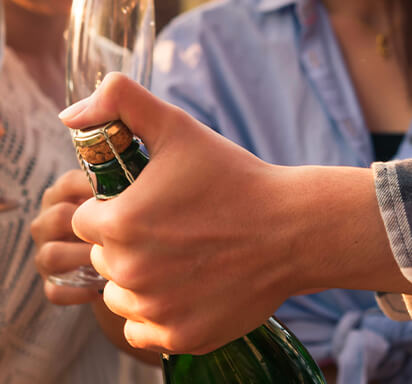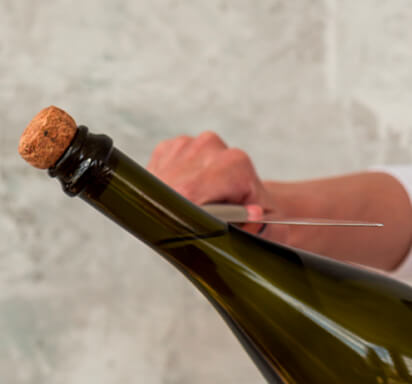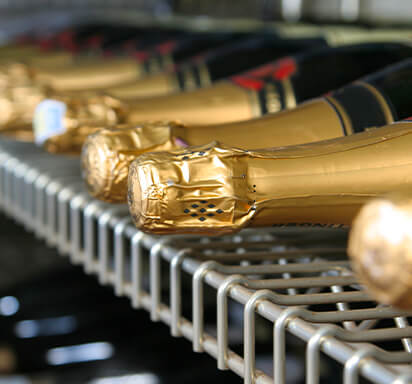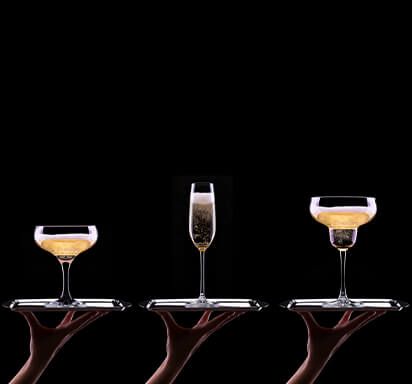The Champagne Cork : Its history, design and how to reuse it

Guardian of the bottle and the precious bubbly inside, the cork serves an essential role in the preservation of Champagne. Over the years, it has evolved and adapted to this very special role.
Guardian of the bottle and the precious bubbly inside, the cork serves an essential role in the preservation of Champagne. Immediately following disgorgement, this porous, mushroom-shaped stopper is squeezed into the glass neck of the bottle, blocking the pressure from escaping and the oxygen from flooding in. Over the years, it has evolved and adapted to this very special role. Learn more about the history, design and creative ways to reuse a Champagne cork!
A BRIEF HISTORY OF CHAMPAGNE CORKS
Although the inventor of cork-based wine stoppers remains a mystery, the latter were born sometime in the mid-17th century. Before this time, winemakers would use a broquelet (basically a wooden toggle wrapped in hemp and then soaked in tallow) to plug their bottles. This technique was far from full-proof, however, and often led to leaking bottles.
Local legend in the Champagne region attributes their invention to the Benedictine monk Dom Pierre Perignon, after whom Dom Perignon Champagne was named and who is also said to have invented the traditional method of sparkling wine production, involving fermentation taking place in the bottle of sparkling wine. This legend has, nevertheless, been debunked.
By the 18th century, the use of corks had become well-documented, especially after King Louis XV issued an edict on the bottling of Champagne. Back then, winery workers would squeeze the corks into Champagne bottles by hand, tying them with twine to keep them in place. This led to frequent accidents, the pop of a Champagne cork potentially leading to the loss of an eye. By the 19th century, winery workers would wear masks made of wire and gauze to protect against the Champagne cork.
It was not until the 20th century that the process of inserting corks into sparkling wine bottles was mechanized. Today, corking Champagne is a perfectly safe step in its production process.
CHAMPAGNE BOTTLE AND CORK DESIGN
Champagne and sparkling wine corks typically have a diameter of 1.2 inches and are 2 inches long. Before pushing the cork into the bottle neck, the corks are compressed to around 60-70% of their original diameter. In fact, these corks are originally perfectly cylindrical. The compression of the bottom segment before insertion gives the Champagne cork its iconic mushroom shape.
Most sparkling wine and Champagne corks have 3 different sections, named agglomerated corks. The bottom of the stopper features two natural cork disks stacked against each other. The bottom disk, which stays in contact with the wine, is referred to as the mirroir (mirror). The top section is made of reconstituted granules of cork held together by glue. The microscopic pores in the cork allow a very small amount of oxygen to filter in, leading to micro-oxygenation, crucial in the aging process.
All natural Champagne corks must bear the name of the Champagne appellation, as well as the vintage for vintage style champagne.
When it comes to Champagne, the pressure created by secondary fermentation in the bottle of wine pushes out the cork once it is ready to be opened, contributing to the famous “cork pop” we know and love, especially at a celebration like a wedding or birthday party. Curious how to open a bottle correctly? Take a look at our article entitled “How to open a Champagne bottle!”.
HOW IS A BOTTLE OF CHAMPAGNE OR SPARKLING WINE CORKED?
Immediately after a wine is disgorged to remove the dead yeast cells and dosed with a mixture of wine and sugar, it is sent for corking. The sparkling wine cork is first compressed into the mushroom shape and then squeezed into the neck of the wine bottle by a machine specially designed for this purpose. After insertion into the sparkling wine or Champagne bottle, the cork is held in place by a wire cage, also known as a muselet.
Following the corking process, the bottles with champagne cork already in them are vigorously shaken in a process known as poignettage. This allows the liqueur de dosage to marry with the wine. The bottles are then set aside for a few months or even years of aging in the cellars of the Champagne house before commercial release. For more information on how Champagne is made, discover our article entitled “What is Champagne?”
HOW TO REUSE CORKS: WINE CORK PROJECTS
Wine corks and Champagne corks are cork objects, made from the bark of a cork oak tree. While some wine stoppers are made of plastic or artificial cork, Champagne corks in premium bottles are made from this bark and should be recycled or reused, if possible One fantastic way to reuse them is through wine cork crafts.
Corks of Champagne can be used to create a wide range of decorations. These include cork candle holders, wedding cake toppers, picture frames for your favorite images, keychains and placemats. Browse the web for some creative DIY cork project ideas.
THE CHAMPAGNE CORK TALISMAN
According to Bollinger Champagne House, there is a popular tradition in Champagne, which involves creating a talisman out of a Champagne cork. After opening a bottle of Champagne, the cork is slit with a knife and a coin is slotted into it, transforming it into a talisman that is meant to bring prosperity and lucky to the person in whose honor the bottle has been opened.
The tradition dates back centuries and was inspired by sailors, who would slip their gold louis into their nets in order to ensure a lucky catch. The act is still quite common in the UK, where the person serving the Champagne will traditionally offer this token to the person of honor. As the cork expands and tights over the coin with time, it eventually becomes impossible to remove. This is meant to symbolize the eternal nature of a special celebration, locked in a moment in time.
Ready to order a bottle of Champagne and try out some cork crafts? Or maybe you are asking yourself “Where can I find champagnes near me?” Shop our extensive selection of top champagnes now in stock and available in a wide range of styles, including white and rosé. And for more questions about cork champagne, free shipping or which Champagne glasses to choose, do not hesitate to contact our team directly!
You may like
Unveil the unique characteristics of Champagne Blanc de Blancs and Blanc de Noirs. Learn how these two styles differ in flavor, grape varieties, and food pairings to elevate your Champagne experience.
12/19/2024Discover how Chardonnay, Pinot Noir, and Pinot Meunier shape the distinct character of Champagne. Learn about rare grape varieties and explore notable examples from top producers in the world’s most famous sparkling wine region.
7/4/2024To help you safely open a bottle of bubbly, we have put together a guide with 6 simple steps. Learn more about when to open a bottle of Champagne and how to do it in the safest and most graceful way.
3/11/2023A swift swoop of the knife along the neck of the bottle, followed by a “pop!” as the glass shatters and the “hiss” of the Champagne as it flows out. There is no more festive way of opening a bottle of Champagne than by sabering it
3/8/2023What is the best way to store Champagne or sparkling wine for the short or long term? Find here best storage practices, which will help keep your bottle of bubbly Champagne or sparkling wines fresh for as long as possible.
2/20/2023There is something truly special about opening a bottle of Champagne or sparkling wine. But have you ever wondered what sets apart Champagne from sparkling wineslike Prosecco, Cava and Lambrusco?
2/20/2023
